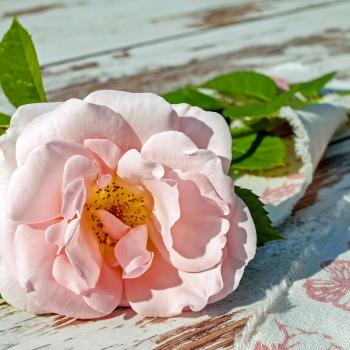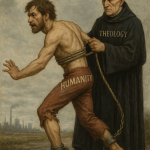So with her father’s blessing light upon her, she rode away beside the prince; and ever after, all her life was crowned with happiness as it had been written for her in the stars.
As a teenager, my ideas about love and romance were actually influenced just as much by Annie Fellows Johnston’s 1904 purity morality tale, The Three Weavers, as they were by Joshua Harris’ I Kissed Dating Goodbye. This was brought to mind recently by a series in which blogger Lana of Wide Open Ground has been running about her childhood reading. She has already talked about Elsie Dinsmore and missionary biographies, both of which I also read voraciously. In this spirit, and as a young adult who holds very different views than I held as a child, I want to take a few posts to go through and discuss The Three Weavers. In this introductory post I will provide some background to the story, along with some words on its popularity today.
Annie Fellows Johnston is the author of the Little Colonel series, which she wrote between 1895 and 1907. (You may be aware of the Shirley Temple version of the first book in this series.) The series centers on a girl named Lloyd Sherman—the granddaughter of a confederate colonel and wealthy plantation owner—growing up in Louisville, Kentucky, in the late nineteenth century. I have to admit, I enjoyed the Little Colonel books more than I did the Elsie Dinsmore books, because while they did include conservative moral lessons, these lessons were less intense and more seamlessly integrated into the books. And unlike Elsie, Lloyd was allowed to have spirit and even a rebellious streak. In other words, Lloyd didn’t read like an abused child.
 In one of the books—The Little Colonel at Boarding School—the mother of one of Lloyd’s friends tells a story called The Three Weavers. This occurs just as Lloyd and her friends are reaching puberty and becoming interested in boys. The story is designed to set the girls off on the right foot when it comes to romantic attachments, and the girls continually refer back to this story through the rest of the books. In other words, this story fundamentally shapes how they think about and carry out their love lives—just as it did for me.
In one of the books—The Little Colonel at Boarding School—the mother of one of Lloyd’s friends tells a story called The Three Weavers. This occurs just as Lloyd and her friends are reaching puberty and becoming interested in boys. The story is designed to set the girls off on the right foot when it comes to romantic attachments, and the girls continually refer back to this story through the rest of the books. In other words, this story fundamentally shapes how they think about and carry out their love lives—just as it did for me.
While I discovered the story through reading the Little Colonel series, other girls growing up in the patriarchal wing of the Christian homeschooling world today come upon the story much more directly. Vision Forum, for example, sells the story in its own volume and advertises it as a timeless story for fathers and daughters. It advertises it as follows:
In The Three Weavers, discover a special story about three weavers who each prepare their daughters to weave a mantle perfectly suited for the prince. Although all three daughters receive the same task, two of them suffer the consequences of poor choices while only one reaps the benefits of yielding to wise counsel.
This beautifully-illustrated allegory is a special book for fathers to read to their daughters over and over again. Sure to become a favorite in your little girl’s library!
Another company I hadn’t heard of before has republished the book along with a study guide, calling it The Three Weavers Plus Companion Guide: A Father’s Guide to Guarding His Daughter’s Purity. Here is the advertising blip:
Fathers understandably feel awkward discussing purity with their daughters. However, The Three Weavers Plus Companion Guide invites fathers to bravely assume their God given responsibility to protect their daughter s purity for marriage while cultivating a close, loving relationship that will influence future generations.
Though I haven’t read it, the study guide apparently consists of six lessons:
- Discover God’s perfect plan for marriage.
- Explore ways to preserve your daughter’s purity
- Cultivate discernment and discretion.
- Define your expectations of your daughter’s “prince”.
- Create a hope chest.
- Commemorate the journey with a Purity Ceremony.
For a critique of the study guide, see this excellent blog post.
The point I’m trying to make is simply that while Johnston’s The Three Weavers—a morality tale penned almost a century ago about the importance of protecting girls’ sexual and emotional purity—seemed fairly new in patriarchal circles when I was a teen, it appears to be becoming only more popular today. With that background, I want to turn to the story itself. In the posts to come, I’m going to post the story in four parts—it’s in the common domain now, so I can post the whole thing—with a word of commentary at the end of each section. Continue on in Part II.














